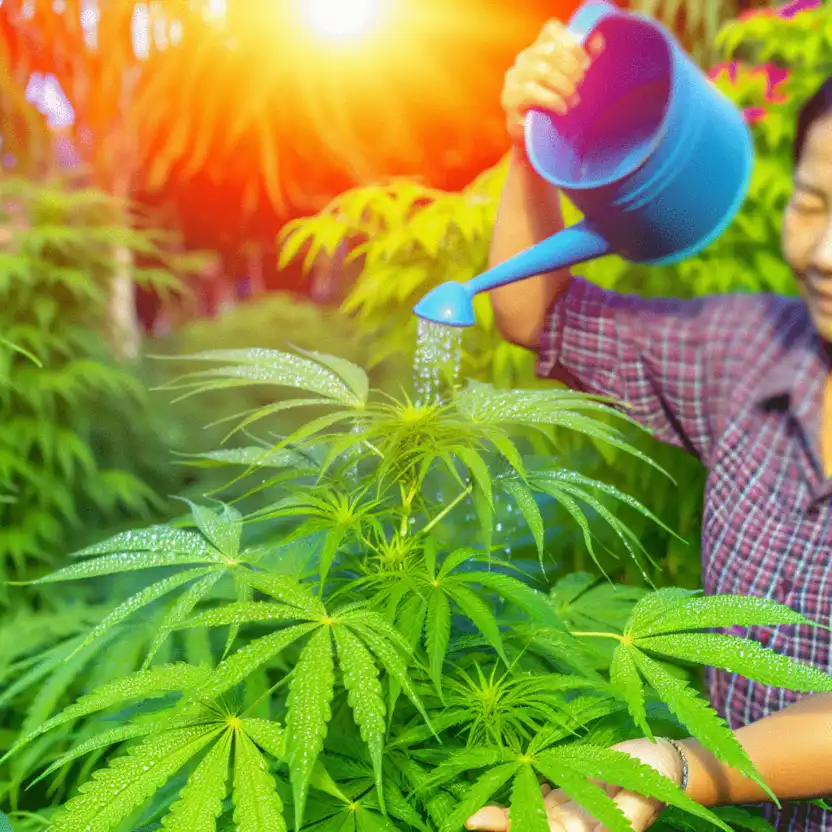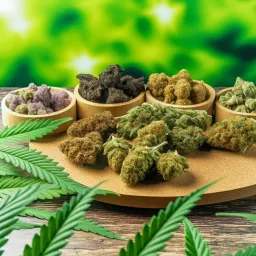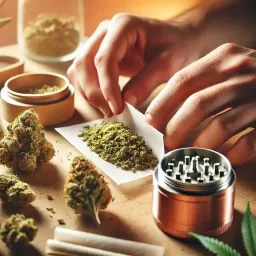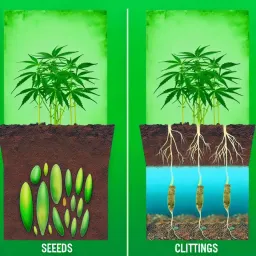Watering Cannabis Plants the Right Way
Did you know that the quality and frequency of watering can significantly impact the yield of cannabis plants? Mastering the art of watering is crucial for growers looking to achieve healthy growth and robust harvests.
What You Will Learn
- Water is essential for nutrient absorption, affecting overall growth and yield.
- Proper watering schedules vary by growth stage; seedlings need less water, while flowering plants require more.
- Quality of water matters—distilled water is often better than tap water due to fewer chemicals.
- pH levels between 6.0 and 7.0 are crucial for optimal nutrient uptake in cannabis plants.
- Signs of overwatering include leaf curl and yellowing leaves, while underwatering leads to wilting and dry soil.
- Using moisture meters or finger tests can help accurately assess soil moisture for effective watering.
- Integrating nutrient solutions with water can enhance growth; adjust fertilizers based on the plant's growth stage.
- Environmental sensors can optimize your watering routine by providing real-time moisture data and alerts.
Understanding the Significance of Properly Watering Cannabis Plants
The Role of Water in Cannabis Growth and Development
Importance of Water for Nutrient Absorption
Water is a vital element for the growth of cannabis plants. It not only nourishes the plant but also helps in the absorption of essential nutrients. Without sufficient water, the roots struggle to take up nutrients, leading to poor growth and yield. For more on optimizing nutrient absorption, check out our article on nutrients for healthy cannabis growth.
Effects of Water on Cannabis Plant Health
Proper watering directly impacts the overall health of cannabis plants. When plants receive the right amount of water, they thrive, producing vibrant leaves and robust buds. Conversely, both overwatering and underwatering can lead to issues such as root rot or stunted growth, affecting the plant's ability to produce high-quality yields.
Essential Factors Influencing Cannabis Watering Techniques
Identifying the Right Watering Schedule for Cannabis Plants
Understanding Different Growth Stages and Their Water Needs
Cannabis plants have varying water needs during different growth stages. Seedlings require less water, while flowering plants need more to support bud development. By adjusting watering based on growth stages, you can ensure your plants are receiving optimal hydration needed for each phase. For a detailed understanding of cannabis growth stages, refer to our guide on cannabis growth stages.
Environmental Factors Affecting Watering Frequency
Several environmental factors influence how often you should water your cannabis plants. Temperature, humidity, and light intensity all play significant roles. For instance, hotter conditions may lead to quicker evaporation, requiring more frequent watering.
Choosing the Right Water for Your Cannabis Plants
Tap Water vs. Distilled Water: What’s Best for Cannabis?
When it comes to watering cannabis, the quality of water matters! Tap water is often treated with chemicals, which might not be ideal for your plants. On the other hand, distilled water is free from these chemicals, making it a better choice for many growers.
The Effect of pH Levels on Cannabis Water Quality
The pH level of your watering source can significantly impact nutrient absorption. Ideally, the pH should be between 6.0 and 7.0 for healthy cannabis growth. Regularly testing and adjusting the pH of your water can prevent nutrient lockout and promote better overall plant health.
Techniques for Watering Cannabis Plants with Precision
Best Practices for Watering Cannabis in Soil
How to Assess Soil Moisture for Optimal Watering
Knowing when to water your cannabis plants is crucial! One effective method is to stick your finger about an inch into the soil. If it feels dry, it’s time to water; if it’s still moist, wait a bit longer.
Techniques for Effective Watering in Containers
When it comes to container gardening, uniform watering ensures every part of the root system gets hydration. A few techniques include:
- Watering until you see runoff at the bottom of the pot.
- Using a moisture meter for accurate readings.
- Employing a slow, steady watering method to avoid flooding.
Innovative Watering Methods for Hydroponics and Soilless Cultivation
Advantages of Drip Irrigation for Cannabis Plants
Drip irrigation systems offer a precise watering solution for cannabis growers. This method delivers water directly to the roots, minimizing waste and ensuring consistent moisture levels. It’s particularly beneficial in hydroponic setups where maintaining water balance is crucial.
Using Self-Watering Systems for Consistent Moisture Levels
Self-watering systems can be a game-changer for busy growers! These systems allow for consistent moisture without daily monitoring. They help maintain optimal hydration levels, reducing the risk of both overwatering and underwatering.
Pro Tip
Did you know? Testing your water regularly can save your cannabis plants from potential nutrient issues. Using a simple pH test kit, ensure your water stays within the ideal pH range of 6.0 to 7.0. This not only promotes better nutrient absorption but also keeps your plants healthier in the long run.
Recognizing Signs of Overwatering and Underwatering in Cannabis Plants
Common Symptoms of Overwatered Cannabis Plants
Overwatering cannabis plants can lead to serious problems, and it’s important to spot the symptoms early. One of the most common signs is leaf curl, where the leaves start to bend downward. You may also notice yellowing leaves and potential root rot if the problem persists.
- Leaf Curl: Leaves may curl downwards, resembling a claw.
- Yellowing Leaves: Lower leaves turn yellow and may drop off.
- Root Issues: Roots can rot, leading to stunted growth and poor health.
If you think your plants are overwatered, take action quickly! To revive overwatered cannabis plants, consider reducing the watering frequency and allowing the soil to dry out. You can also improve drainage by repotting to a container with better aeration.
How to Revive Overwatered Cannabis Plants
Reviving overwatered cannabis plants requires some care. Start by checking the soil moisture using a moisture meter or your finger. If it feels overly wet, it's time to take action:
- Stop watering for a few days, allowing the soil to dry.
- Ensure the pot has adequate drainage holes.
- If needed, consider using a fan to improve airflow around the plant.
- Repot the plant in fresh, dry soil if root rot is visible.
Understanding the Symptoms of Underwatered Cannabis Plants
On the flip side, underwatering can also hinder the growth of cannabis plants. A clear indicator of underwatering is wilting, where the leaves lose their firmness. You might also see drooping leaves and dry, cracked soil.
- Wilting: Leaves appear limp and lack firmness.
- Drooping Leaves: Leaves droop downwards, signaling stress.
- Dry Soil: The topsoil feels dry and may crack.
To effectively rehydrate underwatered cannabis, you need to act quickly! Start gradual watering to avoid shocking the plant. Water the soil thoroughly, letting it absorb moisture, but avoid flooding the roots.
Effective Strategies to Rehydrate Underwatered Cannabis
Here are some effective strategies to help your underwatered cannabis plants recover:
- Water slowly and evenly, ensuring deep soil penetration.
- Use a moisture meter to monitor soil hydration levels.
- Implement a regular watering schedule to prevent future issues.
Optimizing Your Cannabis Watering Routine for Maximum Yield
Integrating Nutrient Solutions with Water for Enhanced Growth
Combining nutrient solutions with water can significantly enhance cannabis growth. Choosing the right fertilizers to mix with water is essential for providing the necessary nutrients. Look for balanced fertilizers that contain nitrogen, phosphorus, and potassium, which are vital for plant health.
Choosing the Right Fertilizers to Mix with Water
When selecting fertilizers, consider the stage of growth your plants are in. Here are some options:
- Vegetative Stage: Use high-nitrogen fertilizers for leafy growth.
- Flowering Stage: Switch to fertilizers higher in phosphorus and potassium to promote blooming.
- Organic Options: Consider using worm castings or fish emulsion as natural fertilizers.
Understanding Feeding Schedules for Healthy Cannabis Plants
Effective feeding schedules are vital for maintaining healthy cannabis plants. A good rule of thumb is to fertilize every two weeks during the growing phase. Adjust based on the plant’s response and environmental conditions.
Maintaining a Consistent Watering Schedule for Robust Cannabis Harvests
Consistency is key when it comes to watering cannabis plants. Implementing a steady watering routine helps prevent both overwatering and underwatering. Utilize environmental sensors to monitor moisture levels accurately and adjust your watering schedule accordingly.
Utilizing Environmental Sensors for Accurate Watering
Environmental sensors can help you stay on top of your plants' water needs. These tools provide real-time data, allowing you to:
- Monitor soil moisture levels accurately.
- Receive alerts when soil is too dry or too wet.
- Optimize your watering schedule based on environmental conditions.
Final Thoughts on Mastering the Art of Watering Cannabis Plants
Mastering the art of watering cannabis plants is crucial for achieving maximum yield. By recognizing the signs of overwatering and underwatering, integrating nutrient solutions, and maintaining consistent watering schedules, you can promote healthy growth. Remember that each plant is unique, so adjusting your approach based on their specific needs will lead to the best results!
Recap of Key Points
Here is a quick recap of the important points discussed in the article:
- Water's Role: Essential for nutrient absorption and overall plant health; both overwatering and underwatering can harm growth.
- Watering Schedule: Adjust based on growth stages; seedlings need less water while flowering plants require more.
- Water Quality: Use distilled water when possible, and maintain a pH level between 6.0 and 7.0 for optimal nutrient absorption.
- Soil Moisture Assessment: Check soil moisture before watering; dry soil indicates it's time to water.
- Signs of Overwatering: Look for leaf curl, yellowing leaves, and root issues; act quickly to revive overwatered plants.
- Signs of Underwatering: Wilting, drooping leaves, and dry soil indicate underwatering; water gradually to rehydrate.
- Nutrient Solutions: Combine fertilizers with water based on the growth stage to enhance plant health.
- Consistency is Key: Maintain a regular watering schedule and use environmental sensors for accurate monitoring.
FAQs About Watering Cannabis Plants
1. How often should I water my cannabis plants?
The frequency of watering depends on the growth stage and environmental conditions. Seedlings need less water, while flowering plants require more.
2. What type of water is best for cannabis?
Distilled water is often better than tap water because it contains fewer chemicals. It's essential to check the pH level as well.
3. What are the signs of overwatering cannabis plants?
Common signs include leaf curl, yellowing leaves, and potential root rot. It's crucial to act quickly to revive the plants.
4. How can I tell if my cannabis plants are underwatered?
Symptoms of underwatering include wilting, drooping leaves, and dry, cracked soil. Gradually watering the plants can help them recover.
5. Why is pH important for cannabis plants?
The pH level affects nutrient absorption. Ideally, the pH should be between 6.0 and 7.0 for healthy cannabis growth.
Latest Posts
Health Benefits
Consumption






